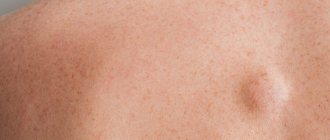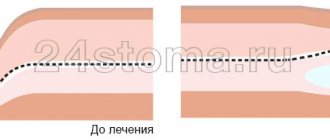Lipoma is a benign tumor that develops from adipose tissue. In most cases, it is located subcutaneously, less often in deep soft tissues. It can be either a single formation or multiple. It grows slowly, and the growth of the lipoma is not affected by the patient’s condition; it can grow to enormous sizes even with general exhaustion. Sometimes its growth accelerates as the patient's weight increases. It can be painful, but only with palpation or physical impact on it. The tumor does not go away on its own.
Surgery
Lipoma removal is performed through a small skin incision, the length of which does not exceed a few centimeters. During the operation, the formation is destroyed and removed along with the capsule, after which the completeness of removal is monitored using a mini-endoscope.
In our clinic, ultrasonic scissors (Harmonic) are used during the operation, which makes it possible to minimize tissue damage and eliminate the risk of bleeding. In addition, intersection and coagulation of vessels whose diameter does not exceed 5 mm is possible without the application of clips or ligatures. Using this technique allows you to avoid tissue burns, which can cause inflammation. The duration of the operation and the pain experienced by the patient are also significantly reduced.
After removing the lipoma, cosmetic intradermal sutures are applied that do not need to be removed, and to cover the postoperative wound, our clinic uses a new generation drug “Dermobond” - a protective film reliably protects the wound from moisture, infection, etc., and prevents the edges from diverging. This eliminates the need for daily dressings, and the patient can shower without fear of wound infection. After 1-2 weeks, the glue washes off on its own.
It is also possible to remove a lipoma using an electrocoagulator in the Valleylab mode (FORCE TRIAD, Switzerland). In this case, the traumatic effect on the tissue is minimal, the incision is carried out simultaneously with coagulation (stopping bleeding), which helps prevent the appearance of postoperative hematomas and the formation of rough scars. Thanks to electrosurgery, it became possible to remove the lipoma without bleeding and subsequent suturing. In addition, due to coagulation of nerve endings in the wound, painlessness is ensured in the postoperative period. Due to the bactericidal effect, there is no risk of developing edema or purulent complications. It should also be noted that the rehabilitation period is short: the very next day the patient can return to his usual pastime. Full recovery occurs within a week.
Types of wen
A fatty tumor or lipoma can have a different structure. Depending on it, it is customary to distinguish several types of lipomas:
- the classic version, in which the tumor contains only adipose tissue;
- fibrolipomas, in which the wen contains connective tissue elements in addition to adipose tissue;
- myotype, in which the lipoma contains muscle fibers in addition to fat;
- angiotype, in which there are vessels in the wen;
- mix variety containing mucous tissue;
- myeloid variety, characterized by the content of hematopoietic tissue in the lipoma.
Pathological neoplasms can also be divided depending on the location where they are located. For example, there are ring formations of the neck, diffuse wen that do not have clear boundaries, formations localized inside the joints, etc.
The characteristics of the symptoms will vary greatly depending on the type of wen and the reasons for its formation. Some pathologies may not make themselves felt for years, existing in the human body, and some, despite being benign, can cause serious inconvenience, greatly reducing a person’s quality of life.
Cost of the operation
The cost of surgery is influenced by a number of factors, primarily the size of the tumor. Therefore, for more complete information, it is better to call by phone.
Causes of lipoma formation
There are several versions of the formation of lipoma. Many believe that genetic predisposition is the leading factor; As a rule, in this case the tumor appears at a young age. The possibility of disease due to metabolic disorders in adipose tissue is also considered. In addition, we cannot exclude the possibility of a tumor appearing due to hormonal disorders: menopause, damage to the hypothalamus, which is responsible for metabolism in the body. There is also a hypothesis that soft tissue injuries can trigger the disease.
It should be noted that there are a number of unfavorable factors that can provoke the appearance of lipoma: diseases of the liver, pancreas, insufficient function of the thyroid gland. It is also possible that the pituitary gland influences the production of hormones responsible for metabolism, growth, and reproductive function. Lipoma is often diagnosed in patients with diabetes, malignant tumors of the respiratory tract, as well as in people suffering from alcoholism.
Symptoms
As a rule, with lipomas there are no symptoms; in most cases, a person is only concerned about a cosmetic defect. Pain or a feeling of discomfort occurs only when the tumor begins to put pressure on nearby organs and tissues, or begins to grow rapidly, and the pain occurs due to stretching of the lipoma’s own capsule. For example, difficulty breathing or swallowing may occur when there is pressure on the airway or larynx.
Diagnostics
Diagnosis of lipoma located superficially does not represent there. The diagnosis is made on the basis of palpation and a mandatory ultrasound examination, which shows the structure of the tissue and excludes the presence of a pathological vascular network characteristic of malignant tumors (for example, sarcoma)
Localization
Lipoma is most often located on the abdomen, chest, back, head, neck, as well as on the arms or legs. However, the tumor can also affect internal organs: mammary glands, brain, muscles, etc.
Radio wave removal of lipoma (fat) in Moscow
At the SANMEDEXPERT clinic, wen removal is carried out in several ways:
- Surgical. It is used in cases where neoplasms reach large sizes. All manipulations are performed under general anesthesia. After the operation, a scar remains on the patient’s body, which after a few months begins to fade and becomes less noticeable to others.
- Radio waves. It is performed under local anesthesia, leaves no scars and does not affect the patient’s performance during the recovery period. However, this method can only remove small lipomas.
Is lipoma dangerous?
Patients are often concerned about the extent to which the appearance of lipomas poses a danger to life and health. In most cases - this is important to remember - the neoplasm does not pose a danger, and the only thing that is required of the patient is to observe how it behaves.
Wen tumors are benign tumors primarily because they are not capable of metastasizing or spreading to other tissues. If they had retained this ability, they would have been transferred to the class of malignant tumors.
The greatest danger to humans is the risk of compression of adjacent tissues, which appears if the neoplasm is large. Most often, the nerves are compressed, which leads to unpleasant sensations and a person contacting a doctor.
However, most often patients have one complaint: the wen looks unaesthetic, which is why the question arises that it is necessary to get rid of it.
The risk that the tumor will become malignant is low. Patients are advised to monitor the tumor and sound the alarm if it begins to rapidly increase in size. It is progressive rapid growth that is the first symptom of malignancy, in which you should not waste time and immediately consult a doctor for additional diagnostics.
Prevention
There are no direct recommendations for preventing the appearance of lipomas, since their appearance does not depend on diet or lifestyle. The only method of prevention is regular monitoring (once every six months) of tumors (this is especially true for people who are genetically predisposed to the appearance of various types of tumors).
In addition, a wen may appear in another place after surgery, so you should carefully monitor changes in your body and consult a doctor in a timely manner.
Symptoms of the disease
The main manifestation of the disease is the appearance of a round or oval formation, which is located under the skin. Lipoma can be found on the face, scalp, neck, trunk or limbs. In cases where the formation is located in internal organs or cavities, it often does not manifest itself until it greatly increases in size and begins to compress the organ. To determine lipomas in the heart, liver, pancreas, retroperitoneum, mediastinum, and so on, additional examination methods are necessary.
Under the skin, the formation always has smooth and clear contours, it is painless. Sizes can vary, ranging from a few millimeters to 20 or more centimeters in diameter. Sometimes the formation is quite large and hangs on a stalk. On palpation, the nodule has a soft and elastic consistency, less often - dense, but not lumpy and of uniform consistency.
Is it possible to remove lipomas?
Removing a lipoma is an issue that does not cause controversy among doctors.
The tumor definitely needs to be removed if it reduces the quality of life. For example, a wen can make it difficult to wear clothes, walk, or be constantly injured when washing. People especially often experience discomfort if a wen has formed in the back area, and our medical center is ready to provide such an operation to remove a lipoma on the back.
Indications for tumor removal are:
- painful spasms, pressure on blood vessels, nerve endings, internal organs, muscles;
- if the tumor appears in traumatic areas where there are signs of damage;
- rapid increase in size;
- when the wen interferes with dressing and wearing clothes;
- if a person feels cosmetic discomfort.
You should not immediately rush to the surgical department as soon as a diagnosis of lipoma is made, if there are no above-mentioned symptoms.
Contraindications
At the same time, operations to remove the wen cannot be performed in the following cases:
- the presence of chronic pathologies in the acute phase;
- infectious diseases or inflammation;
- pregnancy and lactation;
- age less than 18 years;
- some chronic diseases (diabetes mellitus, epilepsy);
- presence of oncology.
In such cases, treatment of neoplasms, if it causes discomfort in one form or another, is agreed with a specialist.
Complications
A complication of a lipoma should be considered torsion of the leg and disruption of the blood supply to the neoplasm, if we are talking about a lipoma on the leg. In this case, the node may undergo necrosis or ulcerate, which is accompanied by severe intoxication syndrome and can be life-threatening, so the tumor in this case must be immediately removed.
Another complication of lipoma should be considered its malignancy. Therefore, when active growth of the tumor begins, it is necessary to remove the tumor as quickly as possible and perform a tissue biopsy.
What is the difference between a lipoma and an atheroma?
Atheroma is a benign neoplasm that develops when a person’s sebaceous gland duct is blocked. The symptoms of atheromas and lipomas are very similar, which is why people often confuse them with each other. An atheroma-type growth usually forms in the upper layers of the skin, where the sebaceous glands are in greatest concentration.
Doctors identify a number of signs that can help distinguish atheroma from classic wen. Among them:
- lipomas are not characterized by an inflammatory process;
- upon examination, the fatty-type neoplasm does not have an opening coming out and indicating the gland;
- atheromas have a more elastic, elastic structure;
- atheromas are always subject to removal, unlike lipomas, which are often recommended to be monitored;
- For lipomas, mobility on palpation is more typical;
- upon examination, it becomes noticeable that the atheroma is attached to the skin and protrudes above it as a separate element;
- atheromas can quickly reach quite large sizes, beginning to cause significant inconvenience to the patient;
- Lipomas are characterized by growth on internal organs, which almost never happens in cases of atheromas.
It is important to pay attention to whether there is any discharge of pus from the neoplasm. Atheromas are capable of secreting any substance, since they even have a hole for this. If we are talking about standard wen, then there can be no talk of any pus, since it is not the gland that is affected, and there are simply no holes for the release of substances.
To accurately determine whether a person is worried about a wen or is it atheroma, you need to visit a doctor. Only a professional can establish an accurate diagnosis and choose treatment.
Moreover, it is strictly forbidden to interfere with the integrity of the tumor or make independent attempts to get rid of it. Such actions can not only introduce an infection into the body, but also provoke the growth of a tumor and cause other unpleasant consequences.











